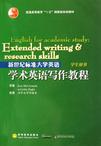新世纪标准大学英语学术英语写作教程
2006-5
高等教育出版社
麦科马克
176
无
随着我国大学英语教学改革的不断深入与发展,大学本科生对英语学习有了更高的要求。许多学生在通过了大学英语四级考试后,希望尽快进入选修课程的学习,如:实用写作、高级听说、英美社会与文化、报刊选读等,以便更有针对性地加强某项语言技能或提高某方面的语言能力和文化素养。从多数院校的实际情况看,高年级或通过大学英语四级考试后的学生开设英语选修课程已成为高校大学英语课程建设与发展的一个重要的方面。 为了更好地适应大学英语教学这一发展趋势以及学生的需要,高等教育出版社引进了由英国里丁大学开发、Gamet出版社出版的本系列教材,并将其列入《新世纪标准大学英语》系列教程。这套教材以学术性写作和阅读为主体,针对具有较好英语基础的大学生和研究生而设计,以语言运用培养为主线,以学术内容为基础。其主要特点是: 1.选材新颖,内容丰富,题材广泛;具有强烈的时代气息;有利于拓宽学生在英语方面的视野及知识面。 2.语言规范,难度适中,语言实践性强;适合于大学高年级学生的实际需要,能够达到((大学英语课程教学要求》的相关要求。 3.教学内容实用,注重学术英语的培养,有利于学生较早地了解这方面的知识,为将来的工作打下相应的基础。 为了使这套教材能够更好地符合我国大学英语选修课程的教学需要,我们做了以下工作: 1.根据《大学英语课程教学要求》对选修课程的要求,将这套系列教材合并为两册,即《学术英语阅读教程》和《学术英语写作教程》。 2.在保持原书风格的基础上,适当增加相应的练习,以满足我国大学英语教学的需要。 3.在所有增加的练习后面,配有参考答案。扩展写作部分提供参考范文等,以便教师和学生参考。 4.对一些内容和有关文字做了必要的修改,使其更加符合我国国情和大学英语教学的需要。 《学术英语阅读教程》和《学术英语写作教程》分为学生用书和教师用书;每册约需48学时,供一个学期教学使用。主要适用于本科高年级或通过大学英语四级考试的学生使用,也可用于研究生英语选修课程。本教程还适用于自修和准备到国外留学的人员。 由于编者水平有限,错误和疏漏之处一定不少,热忱欢迎批评指正。
为了更好地适应大学英语教学这一发展趋势以及学生的需要,高等教育出版社引进了由英国里丁大学开发、Garnet出版社出版的本系列教材,并将其列入《新世纪标准大学英语》系列教程。这套教材以学术性写作和阅读为主体,针对具有较好英语基础的大学生和研究生而设计,以语言运用培养为主线,以学术内容为基础。《新世纪标准大学英语学术英语写作教程》是《学术英语写作教程》学生用书,约需48学时,供一个学期教学使用。主要适用于本科高年级或通过大学英语四级考试的学生使用,也可用于研究生英语选修课程。本教程还适用于自修和准备到国外留学的人员。
1 Introduction to the skills of extended writing and research2 Using evidence to support your ideas3 Structuring your project and finding information4 Developing your project5 Developing a focus6 Introductions,conclusions and definitions 7 Incorporating data and illustrations8 Preparing for presentations and editing your workA AppendicesK Keys to extensions
The increased number of fixations on SLAs in the hazard condition may reflect the fact thatSLAs (predominantly bus shelters) are a source of potential hazards rather than theadvertisement being the driving force behind the fixation. However, none of the clips containedpedestrians in the bus shelters that housed SLAs, and only fixations on the actualadvertisements were counted (rather than all fixations on any part of the bus shelter beingcounted). All SLAs on bus shelters were on the outside of the shelter resulting in fixationlocations that were distinct from fixations within the shelters (that may have been motivated bya search for pedestrians). Instead we suggest that the intention to move the eyes towards anSLA is motivated by a search for hazards (favouring the horizontal search window), but thesubsequent fixation upon the SLA is probably an inadvertent distraction of attention, andprovides no information regarding potential hazards. Fig. 3 further suggests that when afixation lands upon an SLA in the hazard condition, it tends to produce a longer fixationduration than the average clip fixation. Hazard perception searches in visually clutteredenvironments tend to have higher sampling rates and shorter fixation durations than in lesscomplex environments, until, that is, a hazard is identified. At this point, visual search isrestricted to the localized hazard and fixation durations increase (Chapman and Underwood, 1998). Fig. 3 suggests that the SLAs produce similar effects on fixation durations as an actualhazard, stopping search for other hazards, and potentially reducing peripheral attention, asincreased resources are devoted to the fixated stimulus (Crundall et al., 1999). The comparison of total attention devoted to the advertisements revealed SLAs to holdattention for longer compared to RLAs across both the hazard and advertisement groups. Thereare a number of reasons why this may be the case. First, increased fixation durations are usuallyseen as a measure of processing difficulty (e.g. Rayner, 1998). As half of the SLAs were identicalto half of the RLAs (between-groups), this is less likely to be simply due to systematic differencesin the nature of the advertisements. Instead the increased processing may be due to thelocation of the advertisement. SLAs tend to appear in more cluttered areas of the visual scene,close to other street furniture, passing vehicles, etc. The proximity of distractors to a target haslong been recognized to increase the amount of time it takes to respond to the target (e.g.Eriksen and Eriksen, 1974; Logan, 1996), and visual clutter in realistic scenes tends to increasevisual search time for a target element (Boersema, 1989). The embedded nature of SLAs withina complex scene may produce the same result. RLAs, however, have the benefit of being placedoutside the horizontal window of information, and it is possible that the reduced visual clutterof RLAs background (usually viewed against the sky or high buildings when at the point ofgreatest legibility) results in shorter fixation durations being required to extract the same level ofinformation.A second explanation for shorter fixation, durations and gaze durations on RLAs may be relatedto the visual angle at which they are presented compared to SLAs. Drivers tend to becomeuncomfortable looking away from the road for longer than a second, and prolonged fixationsaway from the road ahead can negatively affect steering behaviour (Land, 1998). Though RLAsmay benefit from being outside the horizontal window (by not distracting attention at thewrong moment, or from the high contrast with a less cluttered background), their location(when most legible) requires the driver to move their eyes further up in the visual scene thandrivers are normally used to. The desire to continue processing a RLA after the initial fixationmust be weighed against the urge to return to looking at the road ahead (typical of many scanpaths——Underwood et al., 2003). The greater the distance between the fixation on anadvertisement and the road ahead, the greater the impulse to return the eyes to the forwardposition as soon as possible. As RLAs are further away from the optimum fixation position thanSLAs, it is natural that drivers will tend to fixate RLAs for a shorter amount of time.

无